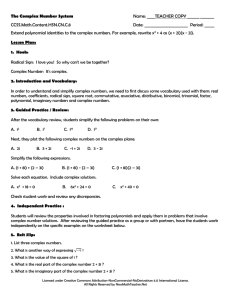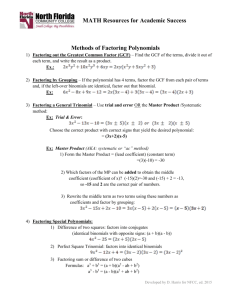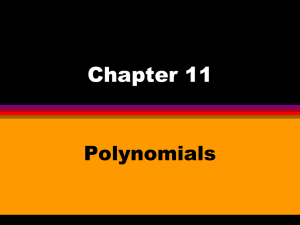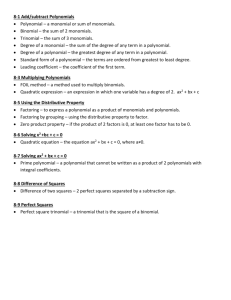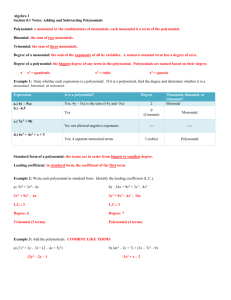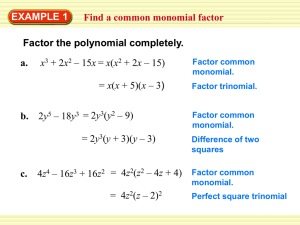Document
advertisement
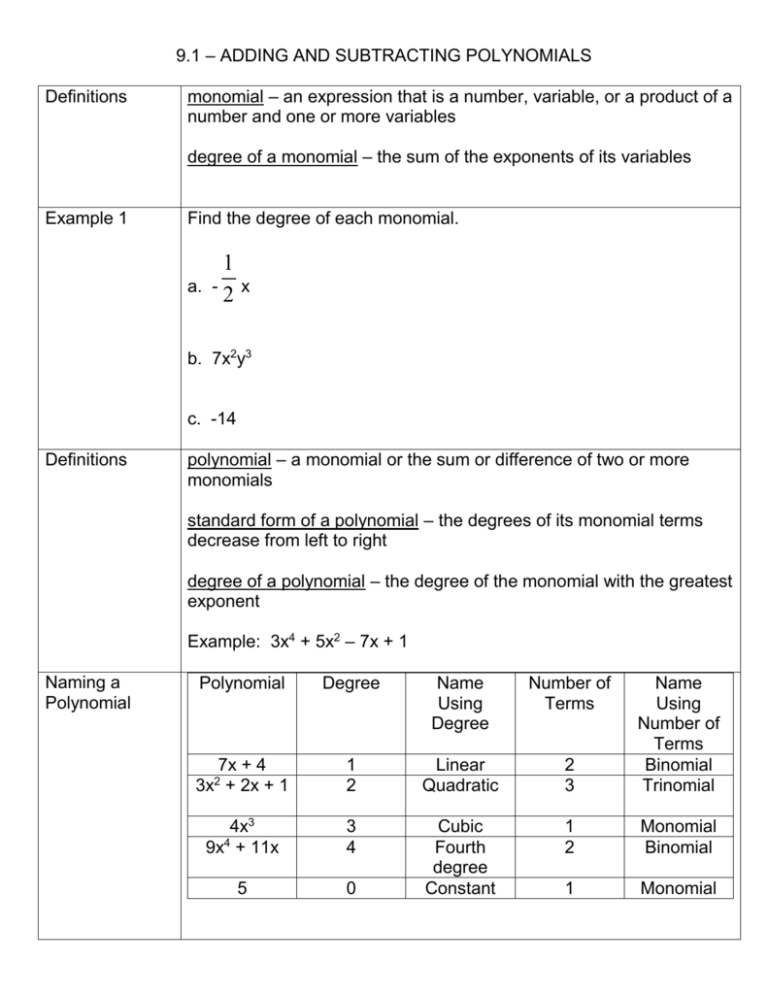
9.1 – ADDING AND SUBTRACTING POLYNOMIALS Definitions monomial – an expression that is a number, variable, or a product of a number and one or more variables degree of a monomial – the sum of the exponents of its variables Example 1 Find the degree of each monomial. a. 1 - x 2 b. 7x2y3 c. -14 Definitions polynomial – a monomial or the sum or difference of two or more monomials standard form of a polynomial – the degrees of its monomial terms decrease from left to right degree of a polynomial – the degree of the monomial with the greatest exponent Example: 3x4 + 5x2 – 7x + 1 Naming a Polynomial Polynomial Degree Name Using Degree Number of Terms 7x + 4 3x + 2x + 1 1 2 Linear Quadratic 2 3 Name Using Number of Terms Binomial Trinomial 4x3 9x4 + 11x 3 4 1 2 Monomial Binomial 5 0 Cubic Fourth degree Constant 1 Monomial 2 Example 2 Write each polynomial in standard form. Then name each polynomial based on its degree and the number of its terms. a. 6x2 + 7 – 9x4 b. 3y – 4 – y3 c. Example 3 8 + 7v – 11v You can add polynomials by adding like terms. Simplify the following. a. (12m2 + 4) + (8m2 + 5) b. (t2 – 6) + (3t2 + 11) c. (9w3 + 8w2) + (7w3 + 4) d. (2p3 + 6p2 + 10p) + (9p3 + 11p2 + 3p) Example 4 Subtracting polynomials will follow the same process as adding, with one additional step. Remember to distribute the subtraction to each value in the second polynomial – “keep, change, change.” Then, we can add just like we did in the last example. Simplify the following. a. (v3 + 6v2 – v) – (9v3 – 7v2 + 3v) b. (30d3 – 29d2 – 3d) – (2d3 + d2) c. (4x2 + 5x + 1) – (6x2 + x + 8) 9.2 – MULTIPLYING AND FACTORING Methods Distributive Property - we will use the distributive property to multiply by a monomial Example 1 Simplify each product. a. 4b(5b2 + b + 6) b. -7h(3h2 – 8h – 1) c. Example 2 2x(x2 – 6x + 5) Factoring a polynomial reverses the multiplication process. To begin factoring, we first find the greatest common factor (GCF) of its terms. Find the GCF of the terms of each polynomial. a. 5v5 + 10v3 b. 3t2 – 18 c. 4b3 – 2b2 – 6b Example 3 Factor each polynomial. a. 8x2 – 12x b. 5d3 + 10d c. 6m3 – 12m2 – 24m 9.3 – MULTIPLYING BINOMIALS Methods There are two methods to multiply binomials. 1. FOIL 2. The Box Example 2 Simplify each product. * FOIL – First, Outer, Inner, Last a. (x + 7)(x + 9) b. (3x – 4)(2x + 5) c. (y + 4)(5y – 8) d. (7m – 2p)2 Example 3 Simplify each product. * The Box a. (a – 8)(a – 9) b. (3c – 7)(2c – 5) c. (5y + 1)2 d. (2y + 5)(y – 3) Example 4 Find the area of each shaded region. Simplify. a. 2x - 6 x+3 b. x 3x -2 Example 5 You may also be asked to multiply a binomial and a trinomial. Simplify each product. a. (6n – 8)(2n2 + n + 7) b. (4x2 + x – 6)(2x – 3) 9.5 – FACTORING TRINOMIALS OF THE TYPE x2 + bx + c Definitions Factoring – reversing the process of multiplication 15 = 3 x 5 We will use the box and work in reverse to find the binomials that multiplied to reach the trinomial. Example 1 Factor each expression. a. g2 + 7g + 10 b. v2 + 21v + 20 c. k2 – 10k + 25 d. q2 – 15q + 36 e. m2 + 8m – 20 f. y2 – y – 56 Example 2 You can also factor trinomials that have more than one variable. Factor each expression. a. x2 + 11xy + 24y2 b. v2 + 2vw – 48w2 9.6 – FACTORING TRINOMIALS OF THE TYPE ax2 + bx + c Note We will continue to use the box and work backwards to find the binomials that multiplied to give the trinomial result. Example 1 Factor each expression. a. 2y2 + 5y + 2 b. 6n2 – 23n + 7 c. 2y2 – 5y + 2 d. 5d2 – 14d – 3 e. 2n2 + n – 3 f. 20p2 – 31p – 9 Example 2 Some polynomials have a GCF, always check for a greatest common factor before trying to factor the problem. The smaller the numbers are the easier factoring will be for you! Factor each expression. a. 2v2 – 12v + 10 b. 4y2 + 14y + 6 c. 18k2 – 12k – 6 Examples Factor each expression. a. x2 + 8x + 16 b. n2 – 16n + 64 c. 9g2 – 12g + 4 d. 4t2 + 36t + 81 Example 2 Factor each expression. a. x2 – 36 b. m2 – 100 c. 9v2 – 4 d. 4w2 – 49 Example 3 Remember to look for a GCF 1st ! Factor each expression. a. 8y2 – 50 b. 28k2 – 7
